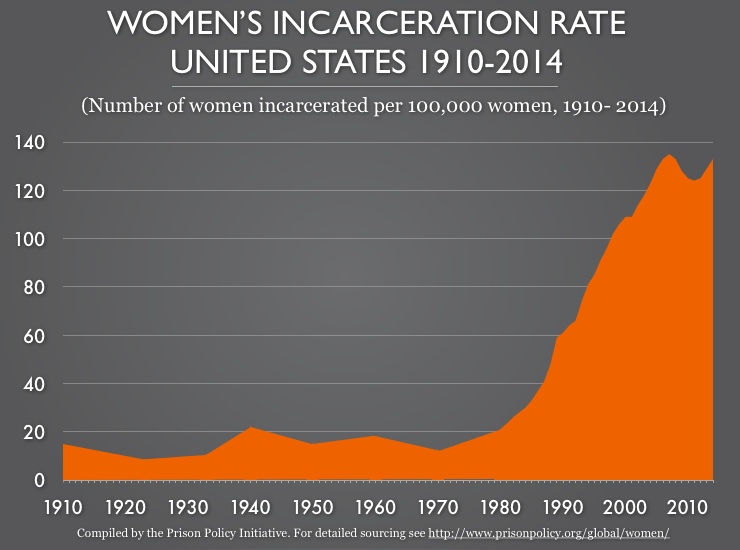
Ava DuVernay’s 13TH is an important, must-see documentary concerning mass and hyper incarceration in the United States. It’s particularly powerful on the Constitutional sources of a national program to imprison thousands of African American men and communities of color. As film critic Manohla Dargis wrote, “Powerful, infuriating and at times overwhelming, Ava DuVernay’s documentary `13TH’ will get your blood boiling and tear ducts leaking. It shakes you up, but it also challenges your ideas about the intersection of race, justice and mass incarceration in the United States, subject matter that could not sound less cinematic.” Who’s missing at the intersection of race, justice and mass incarceration? Women. Where are the women prisoners in this account? Almost nowhere to be seen.
The most salient omission of women prisoners in the history as told by 13TH is in the section concerning the war on drugs. While the intent of that war, from Nixon to today, is brilliantly depicted, the fact that the war on drugs has made women the fastest growing prison population is never mentioned. In 2014, the National Research Council released The Growth of Incarceration in the United States: Exploring Causes and Consequences, a review of the literature on mass incarceration in the United States over the preceding four decades, which reported the following:
For four decades, women have been the fastest growing prison population. The United States has one third of the world’s female prison population. The majority of women in prison are mothers. Women’s prisons are historically `under resourced’ and that situation is only getting worse. Women prisoners face particularly high rates of sexual violence from prison staff. Women prisoners have exceptionally high rates of PTSD, mental illness, and alcohol and drug dependence. Women prisoners have astronomically, shockingly high rates of abnormal pap smears. Here are some highlights:
“More than 200,000 women are in jails or prisons in the United States, representing nearly one-third of incarcerated females worldwide. The past three to four decades have seen rapid growth in women’s incarceration rates—a rise of 646 percent since 1980 compared with a 419 percent rise for men”
“Incarceration rates have increased more rapidly for females than for males since the early 1970s. In 1972, the prison and jail incarceration rate for men was estimated to be 24 times higher than that for women. By 2010, men’s incarceration rate was about 11 times higher. Women’s incarceration rate had thus risen twice as rapidly as men’s in the period of growing incarceration rates.”
“Compared with men, women are sentenced more often to prison for nonviolent crimes: about 55 percent of women sentenced to prison have committed property or drug crimes as compared with about 35 percent of male prisoners. Women also are more likely than men to enter prison with mental health problems or to develop them while incarcerated: about three-quarters of women in state prisons in 2004 had symptoms of a current mental health problem, as opposed to 55 percent of men.
“Women’s prisons historically have been under resourced and underserved in correctional systems, so that women prisoners have had less access to programming and treatment than their male counterparts. Women prisoners also are more likely to be the targets of sexual abuse by staff.”
“A majority of women prisoners are mothers, who must grapple with the burden of being separated from their children during incarceration. In 2004, 62 percent of female state and federal inmates (compared with 51 percent of male inmates) were parents. Of those female inmates, 55 percent reported living with their minor children in the month before arrest, 42 percent in single-parent households; for male inmates who were parents, the corresponding figures were 36 and 17 percent.”
That was two years ago. In the intervening period, from the Julia Tutwiler Prison for Women in Alabama to the Lowell Correctional Institution in Florida to Berks Family Detention Center in Pennsylvania to the California Institution for Women to prisons and jails and detention centers from Alaska to South Dakota to Texas to Oklahoma to Virginia to New York and beyond, the situation for women at the intersection of race, class, disability, justice and mass incarceration has worsened. At the same time, women have led and are leading campaigns to do more than end mass incarceration. Ava DuVernay’s 13TH is a great, must-see documentary because it sheds light on the systemic violence committed against people of color in the name of justice and `security’ and because it opens the door to the next great documentary in which must-see women prisoners lay out the map for a justice system that includes and honors all of us.
(Infographic Credit: Prison Policy Initiative)